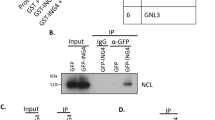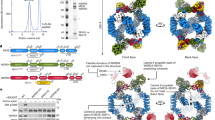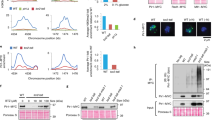Abstract
TOR is the target of the immunosuppressant rapamycin and a key regulator of cell growth. It modulates diverse cellular processes in the cytoplasm and nucleus1,2,3,4,5, including the expression of amino acid transporters, ribosomal RNAs and ribosomal proteins. Despite considerable recent progress, little is known about the spatial and temporal regulation of TOR signalling, particularly that leading into the nucleus. Here we show that Tor1 is dynamically distributed in the cytoplasm and nucleus in yeast. Tor1 nuclear localization is nutrient dependent and rapamycin sensitive: starvation or treatment with rapamycin causes Tor1 to exit from the nucleus. Tor1 nuclear localization is critical for 35S rRNA synthesis, but not for the expression of amino acid transporters and ribosomal protein genes. We show further that Tor1 is associated with 35S ribosomal DNA (rDNA) promoter chromatin in a rapamycin- and starvation-sensitive manner; this association is necessary for 35S rRNA synthesis and cell growth. These results indicate that the spatial regulation of TOR complex 1 (TORC1) might be involved in differential control of its target genes. TOR is known as a classic cytoplasmic kinase that mediates the cytoplasm-to-nucleus signalling by controlling the localization of transcription factors. Our data indicate that TOR might be more intimately involved in gene regulation than previously thought.
This is a preview of subscription content, access via your institution
Access options
Subscribe to this journal
Receive 51 print issues and online access
$199.00 per year
only $3.90 per issue
Buy this article
- Purchase on Springer Link
- Instant access to full article PDF
Prices may be subject to local taxes which are calculated during checkout




Similar content being viewed by others
References
Abraham, R. TOR signaling: an odyssey from cellular stress to the cell growth machinery. Curr. Biol. 15, R139–R141 (2005)
Harris, T. E. & Lawrence, J. C. Jr . TOR signaling. Sci. STKE 2003, re15 (2003)
Shamji, A., Nghiem, P. & Schreiber, S. Integration of growth factor and nutrient signaling: implications for cancer biology. Mol. Cell 12, 271–280 (2003)
Schmelzle, T. & Hall, M. N. TOR, a central controller of cell growth. Cell 103, 253–262 (2000)
Schneper, L., Duvel, K. & Broach, J. Sense and sensibility: nutritional response and signal integration in yeast. Curr. Opin. Microbiol. 7, 624–630 (2004)
Loewith, R. et al. Two TOR complexes, only one of which is rapamycin sensitive, have distinct roles in cell growth control. Mol. Cell 10, 457–468 (2002)
Wedaman, K. P. et al. Tor kinases are in distinct membrane-associated protein complexes in Saccharomyces cerevisiae. Mol. Biol. Cell 14, 1204–1220 (2003)
Drenan, R. M., Liu, X., Bertram, P. G. & Zheng, X. F. S. FKBP12-rapamycin-associated protein or mammalian target of rapamycin (FRAP/mTOR) localization in the endoplasmic reticulum and the Golgi apparatus. J. Biol. Chem. 279, 772–778 (2004)
Desai, B. N., Myers, B. R. & Schreiber, S. L. FKBP12-rapamycin-associated protein associates with mitochondria and senses osmotic stress via mitochondrial dysfunction. Proc. Natl Acad. Sci. USA 99, 4319–4324 (2002)
Rout, M. & Kilmartin, J. in Cell Biology: A Laboratory Handbook (ed. Celis, J. E.), 2nd edn 120–128 (Academic, San Diego, 1998)
Pemberton, L. F., Blobel, G. & Rosenblum, J. S. Transport routes through the nuclear pore complex. Curr. Opin. Cell Biol. 10, 392–399 (1998)
Carvalho, J., Bertram, P. G., Wente, S. R. & Zheng, X. F. S. Phosphorylation Regulates the Interaction between Gln3p and the Nuclear Import Factor Srp1p. J. Biol. Chem. 276, 25359–25365 (2001)
Zheng, X. F., Florentino, D., Chen, J., Crabtree, G. R. & Schreiber, S. L. TOR kinase domains are required for two distinct functions, only one of which is inhibited by rapamycin. Cell 82, 121–130 (1995)
Chan, T. F., Carvalho, J., Riles, L. & Zheng, X. F. S. A chemical genomics approach toward understanding the global functions of TOR. Proc. Natl Acad. Sci. USA 97, 13227–13232 (2000)
Bertram, P. G. et al. Tripartite regulation of Gln3p by TOR, Ure2p and phosphatases. J. Biol. Chem. 275, 35727–35733 (2000)
Cardenas, M., Cutler, N., Lorenz, M., Di Como, C. & Heitman, J. The TOR signaling cascade regulates gene expression in response to nutrients. Genes Dev. 13, 3271–3279 (1999)
Jorgensen, P. et al. A dynamic transcriptional network communicates growth potential to ribosome synthesis and critical cell size. Genes Dev. 18, 2491–2505 (2004)
Zaragoza, D., Ghavidel, A., Heitman, J. & Schultz, M. C. Rapamycin induces the G0 program of transcriptional repression in yeast by interfering with the TOR signaling pathway. Mol. Cell. Biol. 18, 4463–4470 (1998)
Powers, T. & Walter, P. Regulation of ribosome biogenesis by the rapamycin-sensitive TOR-signaling pathway in Saccharomyces cerevisiae. Mol. Biol. Cell 10, 987–1000 (1999)
Moss, T. & Stefanovsky, V. Y. At the center of eukaryotic life. Cell 109, 545–548 (2002)
Warner, J. R. The economics of ribosome biosynthesis in yeast. Trends Biochem. Sci. 24, 437–440 (1999)
Udem, S. & Warner, J. Ribosomal RNA synthesis in Saccharomyces cerevisiae. J. Mol. Biol. 65, 227–242 (1972)
Claypool, J. A. et al. Tor pathway regulates Rrn3p-dependent recruitment of yeast RNA polymerase i to the promoter but does not participate in alteration of the number of active genes. Mol. Biol. Cell 15, 946–956 (2004)
Tsang, C. K., Bertram, P. G., Ai, W., Drenan, R. & Zheng, X. F. S. Chromatin-mediated regulation of nucleolar structure and RNA Pol I localization by TOR. EMBO J. 22, 6045–6056 (2003)
Beck, T. & Hall, M. N. The TOR signaling pathway controls nuclear localization of nutrient-regulated transcriptional factors. Nature 402, 689–692 (1999)
Duvel, K., Santhanam, A., Garrett, S., Schneper, L. & Broach, J. Multiple roles of Tap42 in mediating rapamycin-induced transcriptional changes in yeast. Mol. Cell 11, 1467–1478 (2003)
Martin, D., Soulard, A. & Hall, M. TOR regulates ribosomal protein gene expression via PKA and the Forkhead transcription factor FHL1. Cell 119, 969–979 (2004)
Rudra, D., Zhao, Y. & Warner, J. R. Central role of Ifh1p–Fhl1p interaction in the synthesis of yeast ribosomal proteins. EMBO J. 24, 533–542 (2005)
Schawalder, S. et al. Growth-regulated recruitment of the essential yeast ribosomal protein gene activator Ifh1. Nature 432, 1058–1061 (2004)
Bertram, P. G. et al. Convergence of TOR-nitrogen and Snf1-glucose signaling pathways onto Gln3. Mol. Cell. Biol. 22, 1246–1252 (2002)
Acknowledgements
We thank J. H. Cho for generating the KOG1-MYC9 strain, M. Rout and S. Wente for advice on the purification of yeast nuclei, and H. Sesaki and R. Jensen for Tim23 antibody. This work was supported by an NIH grant to X.F.S.Z. Author Contributions The immunofluorescence experiments were performed by C.K.T. and M.W. Mutagenesis and rapamycin sensitivity assays were performed by H.L. and M.W. Subcellular fractionation, northern blotting and 35S rRNA assays were performed by H.L. ChIP assays were performed by C.K.T. and H.L. Tor1 antibody was generated and characterized by P.G.B. The data were analyzed and interpreted by H.L., C.K.T., M.W., P.G.B. and X.F.S.Z. The data images for the figures were prepared by H.L., C.K.T., M.W. and P.G.B. The manuscript was written by H.L., C.K.T. and X.F.S.Z.
Author information
Authors and Affiliations
Corresponding author
Ethics declarations
Competing interests
Reprints and permissions information is available at npg.nature.com/reprintsandpermissions. The authors declare no competing financial interests.
Supplementary information
Supplementary Information s1
(PDF 2988 kb)
Rights and permissions
About this article
Cite this article
Li, H., Tsang, C., Watkins, M. et al. Nutrient regulates Tor1 nuclear localization and association with rDNA promoter. Nature 442, 1058–1061 (2006). https://doi.org/10.1038/nature05020
Received:
Accepted:
Published:
Issue Date:
DOI: https://doi.org/10.1038/nature05020
This article is cited by
-
mTOR-dependent phosphorylation controls TFEB nuclear export
Nature Communications (2018)
-
Control of RNA polymerase II-transcribed genes by direct binding of TOR kinase
Current Genetics (2018)
-
Non-canonical reader modules of BAZ1A promote recovery from DNA damage
Nature Communications (2017)
-
The effect of epigenetic modifications on the secondary structures and possible binding positions of the N-terminal tail of histone H3 in the nucleosome: a computational study
Journal of Molecular Modeling (2017)
-
CO2 sensing in fungi: at the heart of metabolic signaling
Current Genetics (2017)
Comments
By submitting a comment you agree to abide by our Terms and Community Guidelines. If you find something abusive or that does not comply with our terms or guidelines please flag it as inappropriate.



